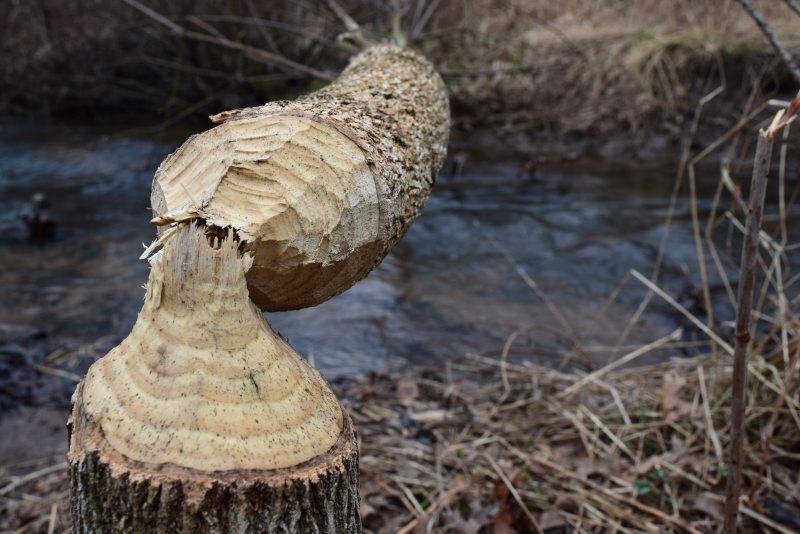
You’ve heard of a red letter day? Well yesterday was a red-beaver day. Here at beaver central we are good at picking up trends and regional changes. We’re usually at the front of the line when it comes to hearing good news. But I’ll be honest, I never expected this.
Draper Fight Centers On Beaver Dams, Wetlands, Flood Control
Two, small beaver dams lie at the heart of a quarrel in Draper. County flood officials are ordering residents to take them down. But the homeowners say the dams protect the wildlife and value of their homes.
Kelly McAdams says the notice of violation letter came on Christmas Eve.
“Inspection by Salt Lake County Flood Control,” he says, reading from the letter, “has indicated that fallen tree limbs and debris have been deposited in the form of a beaver dam into Big Willow Creek, a county-wide drainage facility, without authorization.”
Next month, McAdams goes before an administrative law judge and expects to lose, considering beavers and wetlands have no standing in county law. But he and his wife are set on preserving this patch of habitat for the beavers and all the other creatures that rely on this wetland wonderland.
 Make sure you listen to the story which made NPR this morning and sign the petition, then check out SLTribune.
Make sure you listen to the story which made NPR this morning and sign the petition, then check out SLTribune.
Leave it to beaver? No way, says Salt Lake County
Draper • Big Willow Creek bends and meanders behind Kelly McAdams’ Draper home and her backyard steps down into an urban wildlife preserve.
Thanks to a string of beaver dams, the creek pools into wetlands teaming with life. Ducks and geese nest on the banks lined with cattails; herons and pelicans visit to dine on the 18-inch carp and catfish. Neighborhood kids also fish the ponds.
But where McAdams, his wife, Kris Burns, and neighbors on Dunning Court see an ecological sanctuary, Salt Lake County sees “unauthorized modifications to a countywide drainage facility.”
The county Division of Flood Control has ordered them to remove the dams or face a $25-a-day fine, even though federal wildlife officials say these dams enhance the water quality, hydraulics and riparian habitat
The waterways and channels need to be clear and run and serve their purposes. There is a balancing act,” Graham said. “The county has demonstrated many times it balances wildlife habitat on creeks and waterways as they run through the city.”
Graham has overruled McAdams’ appeal, which is slated to go before an administrative law judge on April 26.
Because my life is just like that I had already heard about this case from the real estate agent representing them who contacted me on April 1 looking for supportive letters to the court on the issue of beavers, water storage, and biodiversity. I put out the usual appeal for help to our beaver friends in Utah but with this new flurry of news I heard this morning from Mary Obrien who is on it. Joe Wheaton is in Europe but I’m hoping he can contribute or at least assign a student to do so. I also heard from our retired attorney friend who won the famous Lake Skinner Beaver case at the appellate level that he would be happy to talk to them and has some ideas to pursue.
“You have all these ecosystem services that keep the entire stream corridor functioning as it should,” said Jones, with the Wild Utah Project. “Many other municipalities across the county are starting to allow beavers back to perform this critical engineering service.”
Meanwhile I know Worth A Dam will write something and mention how a Contra Costa County Flood Control Specialist was on our beaver subcommittee and approved the flow device that controlled flooding and washouts for nearly a decade. I have personally contacted everyone I can think of that might help ‘circle the wagons’ in this case, but more is always needed. If you want to help, email me and I’ll give you contact info. The entire Tribune article is excellent and even talks about flow devices but y requires a little persistent to get past their subscriber wall.
Meanwhile, completely independently but not unrelated, I heard from Michael Pollock yesterday about this prayer-answering article from the unlookedfor source of BeefProducer newsletter. No seriously. It is beautifully written by Editor Alan Newport and he starts out with one of the VERY best lines I’ve ever read. Send this article to every old curmudgeon you know who won’t listen to reason.
In defense of beavers
To reverse streambed erosion the hated beaver is the most likely candidate.
Beavers are the cure we don’t want to take.
It took me many years of study and observation to come to this point in my thinking, but today there is no longer any question in my mind. Read on and you’ll learn why I say so.
I’m almost 60 years old and throughout those years I’ve watched the streams cut deeper and deeper into the soil near my home. On my uncle and aunt’s farm, the little rocky crossing we walked across and drove tractors across and rode horses across without a thought disappeared years ago into a gulch. The entire creek today is much deeper than it was, and so is every other creek, stream and wash I know of.
So the question, I reasoned, was what process had previously stopped this from being a natural course of events that outpaced the normal upturn of new soil through movement of the earth’s crust?
In North America, the only answer I‘ve ever found was … beavers! They once lived by the millions in every state in the union, and new evidence says their homeland stretched across much of Mexico and into the arctic tundra of Canada. I have more recently learned beavers also were common across Europe and Asia.
With all this in our knowledge base now, it seems if beavers were the agent of change and good in streams for hundreds of thousands of years before we arrived, then they could be and should be again. They work day and night, like the cow, without us lifting a finger.
I understand that beavers are a pain in the neck, but so is erosion and droughty land.
I have no particular love for beavers, but I do love the land and God’s creation. It’s my understanding we are to be stewards in His image. So here I stand, saying kind things about one of the most hated creatures in the world of agriculture.
Go read the whole article. And then read it again. It’s really well written and contains an impressive amount of research. It’s even more impressive when you realize that Alan is the editor of BeefProducer and lives in Oklahoma. Meanwhile I’m going to be busy thinking up a graphic for that AWESOME first line and writing my amicus brief to the court in Utah.





 Beavers are found across much of North America, almost anywhere there’s water and wood. They are well-established in most areas of Pennsylvania.
Beavers are found across much of North America, almost anywhere there’s water and wood. They are well-established in most areas of Pennsylvania. Dubbed beaver dam analogues, these structures can be built with hand labor. Even volunteers and children can get involved — no heavy machinery required.
Dubbed beaver dam analogues, these structures can be built with hand labor. Even volunteers and children can get involved — no heavy machinery required.
 MARTINEZ — It started in 2007, when downtown Martinez citizens noticed Alhambra Creek was flowing slow, and that trees along the banks had been gnawed down to little points. The furry, buoyant culprits were elusive at first, but their first dam of sticks, leaves and mud near Marina Vista Avenue told the, er, tail.
MARTINEZ — It started in 2007, when downtown Martinez citizens noticed Alhambra Creek was flowing slow, and that trees along the banks had been gnawed down to little points. The furry, buoyant culprits were elusive at first, but their first dam of sticks, leaves and mud near Marina Vista Avenue told the, er, tail. “Who had even heard of beavers in town before?” said Heidi Perryman, president of the nonprofit Worth a Dam group. Someone she met literally walking down the street told her that beavers lived a few blocks from her Martinez home.
“Who had even heard of beavers in town before?” said Heidi Perryman, president of the nonprofit Worth a Dam group. Someone she met literally walking down the street told her that beavers lived a few blocks from her Martinez home. f people owner Luigi Daberdaku has met over the years. Most of them, he said, came downtown to find the beavers.
f people owner Luigi Daberdaku has met over the years. Most of them, he said, came downtown to find the beavers.


 But Perryman and others were overjoyed when, on March 5, a beaver was seen in the creek near downtown. It’s been seen at least twice since, and photographed at least once.
But Perryman and others were overjoyed when, on March 5, a beaver was seen in the creek near downtown. It’s been seen at least twice since, and photographed at least once.
 etts. They are a remarkable business I happen to love because they turn favorite literature into wearable art. Literally. The entire text of a beloved book becomes a shirt, card, poster, tote or scarf. Catcher in the Rye, Scarlet Letter, Jane Eyre, Hamlet, The Princess Bride, classic or contemporary.
etts. They are a remarkable business I happen to love because they turn favorite literature into wearable art. Literally. The entire text of a beloved book becomes a shirt, card, poster, tote or scarf. Catcher in the Rye, Scarlet Letter, Jane Eyre, Hamlet, The Princess Bride, classic or contemporary.





































